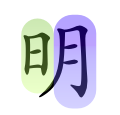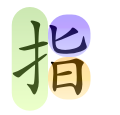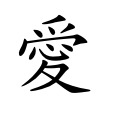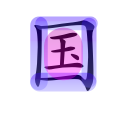
Radical Placement
Radicals are clumped together with other radicals to create more complex kanji. Let's look at the various ways radicals can be placed together.
Simple Combinations
These are as easy as it gets. Two radicals combine either vertically or horizontally, each taking half of a full kanji square. Examples are below.


Please note that most modified radical forms appear at the left-most location of kanji combinations. Exceptions do occur, though, such as the modified form of 火 (fire) appearing at the bottom of 黒 (black).
Complex Combinations
As kanji get more complicated, you find sometimes three and four radicals making up more complex ideas and meanings. Generally, the placement rules for simple combinations are compounded here.
Let's analyze 働 to begin.

We see three separate radicals here clumped together. Its construction is just like the two-half construction above except with an extra half; the kanji is divided into thirds. We'll return to 働 in the next lesson to analyze its meaning by looking at these radicals, but for now let's move on to another.
 Here you see a modified radical on the left half as they usually are. The right half is divided further into quarters. Take note that though three radicals of different sizes combine, the kanji as a whole remains balanced. If thinking in terms of components balancing each other out helps you when it comes to writing kanji out, take that thought and run with it.
Here you see a modified radical on the left half as they usually are. The right half is divided further into quarters. Take note that though three radicals of different sizes combine, the kanji as a whole remains balanced. If thinking in terms of components balancing each other out helps you when it comes to writing kanji out, take that thought and run with it.

See if you can identify all the radicals to the left in the kanji for 'love'. Roll-over with your mouse to see the solution.
If you didn't get it, don't worry - it's a tough one.
Irregular Combinations
Some radicals combine in other strange ways. These needn't be memorized; rather, make yourself familiar with how kanji combine so you'll be better equipped to identify radicals within a really complex character.
A few examples are marked below.



Move on to the next lesson to find out how to put these radicals to good use.